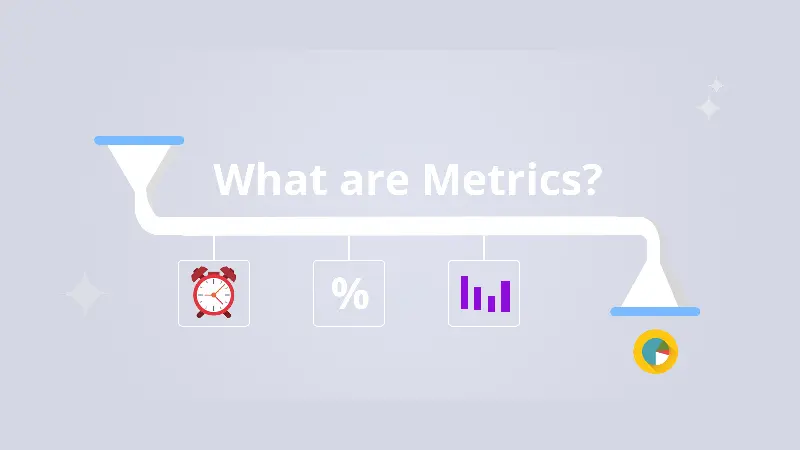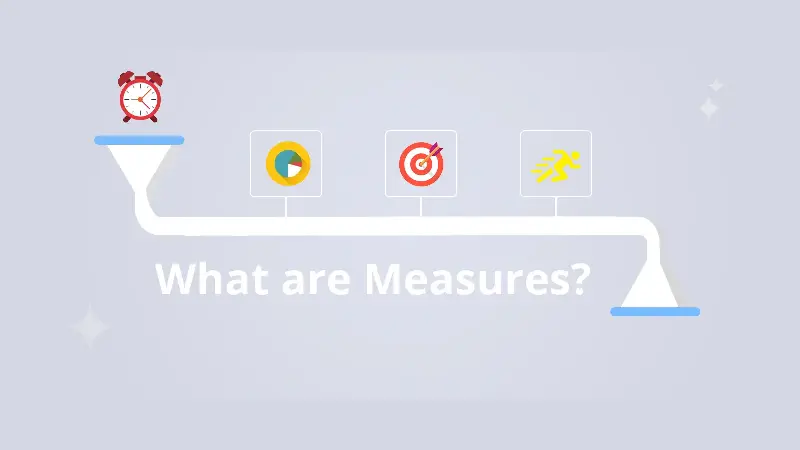Metrics and measures often confuse. They are sometimes confused with each other and often described as the same thing.
It is easy to confuse the two because, in a sense, a metric is a type of measure, albeit a more useful measure that carries more information. While a measure is a simple number, such as, how many miles you have traveled, for example-a metric puts that measure into context - how many miles you have traveled per hour. This additional context makes the same measure orders of magnitude more useful, especially when looking at business KPIs.
An example of an important metric for an online business might be conversions per 1,000 impressions. Knowing that you have twenty conversions is itself a limited measure. If those twenty conversions came from a hundred impressions, that is a very positive Key Performance Indicator. If they came from a thousand impressions, it is less favorable – context is everything.
In this article...
- What is a Metric?
- What is a Measure?
- Examples of Metrics Vs Measures
- What is the difference between a Metric and a Measure?
- Which should I use, example scenarios?
- How to identify and track your Metrics and Measures
- Conclusion

What is a Metric?
A Metric is a measure that is quantifiable. They are used to track specific processes, such as the conversion rate of a marketing or sales initiative. Metrics enable businesses to assess the performance of these processes.
To use our above example of miles traveled, with just the measure (miles) you can only tell how far a person has traveled. By factoring in the time, you can tell how far they traveled, how long it took them, and how fast they were going. In short, a metric is a measure with an additional data point.
For businesses, metrics are crucial in assessing how well the business is doing, typically visualized on dashboards. They essentially repackage the raw measures into useful-yet-easily digestible pieces of information.

What is a Measure?
A Measure is a classification of raw data such as a number or value. They can be calculated via sums or averages and include values representing business-specific measures such as products sold, website visits, goods returned, and calls. Measurements such as operating temperature, speed, and cycles are typically used in manufacturing processes.
Sticking once more with our example of traveling. There are two relevant measures that we have mentioned; distance and time. The combination of these measures gives us a metric, but the measures themselves are essentially blind data, which is to say they make no assertions about the thing they are measuring other than the measurement itself. If we say a person traveled thirty miles, all we can say is the distance they traveled. We would need the additional measure of time to know if they were going fast or slow.
Examples of Metrics Vs Measures
Although the distance traveled and the time it has taken is an excellent, simple example to get across the concept we are dealing with, it helps to see things in a familiar context. SimpleKPI is a platform easily visualizing key performance indicators, so, naturally, we thought it appropriate to give some examples of metrics vs measures from the world of business KPIs.
Abandoned-Calls Rate
The abandoned call rate is a metric that describes the primary calls by a secondary one. An excellent example of this is a call center offering support. If inbound calls were 10,000 in a month, and those disconnected before being answered by a representative were 1,000, that would be an abandonment rate of 10%. In this case, the raw calls and abandoned calls are the measures.
Error Rate
An error rate can be used in a wide range of places, from manufacturing processes to service delivery. Errors are typically an accepted and unavoidable part of running a business, but that doesn't mean you shouldn't strive to reduce the rate of them. An example of an error rate might be the total number of a particular product manufactured vs the number of those products that did not pass quality control.
Turnaround Time
Turnaround time is a very common metric in business that describes the time it takes to complete a task. Unlike our other examples, there is only one measure in this metric-the time taken. The additional data point is the task itself. An example of turnaround time in the real world might be the time it takes for your mechanic to get your car back to you once you've dropped it off at the shop.
What's the Difference Between Metrics and Measures?
The most obvious difference between metrics and measures is that measures are a fundamental unit that in and of itself provides very little information. If you were to receive a report that simply said, "We sold three hundred units," it would not be an especially useful report. Three hundred units of what? Over what time-frame? Were all the units completed sales or were any returned?
Metrics bring together measures with other data points to make them tell a story. If the above report said, "We sold three hundred units of product X over the last quarter," you now have a more substantial picture of how things are going.
And, by combining this metric with the same metric from the previous quarter, you have a valuable KPI. If you sold one hundred units of product X over the last quarter and three hundred units this quarter, you have sales growth of 200% quarter on quarter. You can immediately see how this is a far more useful metric. A report saying that you sold four hundred units over the last two quarters gives you the same information, but it doesn't tell you about the growth from the previous quarter to this one, in much the same way that measure by itself doesn't give you much information at all.
It can help to think of a measure as an ingredient in a recipe. You can't make the recipe without that ingredient, but you wouldn't necessarily want to eat the ingredient by itself.
Which Should I Use?
Like many things in business, there is rarely a one-size-fits-all answer to a question like what measures and metrics you should use. The type of business you run will determine the best metrics to focus on. For example, a company running a loss-leader business model like the one razor blade manufacturers operate would be silly to use the profit of the razors as a KPI. The business model is built around selling the razors at a loss (even giving them away for free!) to get customers to buy their razor blades. In this kind of business model, attach rate would be a far more useful metric since it would describe how successful your business is at getting customers to purchase that primary product.
Alternatively, for a company that repairs computers, the turnaround rate would be a far better metric to treat as a KPI. For this kind of company, success is largely dependent on volume. The more computers repaired, the more profit the company can make. Given that there are only so many people you can employ before your business becomes untenable, faster turnaround times are a useful goal to strive for.
A good, in-depth article relating to choosing the right customer experience by Greg Kihlström, is worth the quick read.
To help get started, we have a list of over 200 industry-focused KPIs to help you jump start your performance monitoring.
How to Identify and Track Your Metrics and Measures
The key to choosing the right KPI metrics is understanding what is important to your business. It helps to take a broad look at your business; take in the big picture, so to speak. It can be very easy to get hung up on certain metrics and measures that, while far from useless, are very minor in the grand scheme of things. For example, putting all of your energy into improving your sales figures when a substantial number of your products are returned as faulty or poor quality is not the best course of action.
The importance of a given KPI is not set in stone. The most metric to focus on for success this year may be entirely different to the metric that was most significant last year.
Business is a dynamic game, and for growth, the key to continuous business improvement requires you to reassess the metrics and measures that drive it. If your company was producing a lot of faulty products and got that error rate down to a reasonable level, it is probably time to shift gears and improve other areas of your business.
Conclusion
Though differentiating between metrics and measures can seem tricky at first, it is, ultimately, a simple distinction.
What is less simple is knowing which metrics to focus on when highlighting KPIs for your business. Visualizing your measures and metrics via KPI Dashboards or KPI Reports can help with this, as it puts the relevant data into an easily digestible format.

by Paulo De Sousa
Paulo writes on the technical side of KPI Tracking. He is a co-founder of SimpleKPI and has worked in the development and SaaS field for over 20 years. He is passionate about helping businesses make data-driven decisions through the use of data, reports, and analytics. With his deep understanding of business intelligence tools, he's adept at providing solutions that can help businesses reach their goals.
